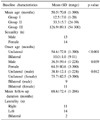Abstract
Purpose
Wilms' tumor typically affects young children, with more than 80% of patients identified before 5 years of age. We evaluated the clinical features of Wilms' tumor according to age.
Materials and Methods
According to their age, 27 patients with Wilms' tumor who underwent radical nephrectomy were classified into group I (under 24 months: n=15), group II (24-48 months: n=4), and group III (over 48 months: n=8), respectively. We retrospectively reviewed tumor size, pathologic features, renal vein invasion, renal capsule invasion, bilaterality, lymphovascular invasion, stage, complete resection, and survival rate.
Results
The mean age of groups I, II, and III was 12.5±7.0 (range, 1-20), 33.3±5.7 (range, 24-39) and 126.9±89.1 (range, 54-300) months, respectively. Bilaterality (p<0.001) and male sexuality (p=0.039) were significantly related to early diagnostic age. Tumor stage (p=0.036) and blastema component (p=0.027) increased with age. Bilaterality and incomplete resection of Wilms' tumor were related to larger size (p<0.001) and vessel/lymph node invasion (p=0.02), respectively. There were no significant differences in tumor volume, anaplasia, capsule invasion, lymph node invasion, vessel invasion, complete resection, laterality, or recurrence according to age. There was also no significant difference in the survival rate according to age.
Figures and Tables
Fig. 2
Relationship of lymph node/vessel invasion and complete resection of Wilms' tumor. a: p=0.02.

Fig. 3
Relationships of survival rate with other characteristics of Wilms' tumor. (A) Age, (B) Pelvocaliceal invasion.

References
1. Arrigo S, Beckwith JB, Sharples K, D'Angio G, Haase G. Better survival after combined modality care for adults with Wilms' tumor. A report from the National Wilms' Tumor Study. Cancer. 1990. 66:827–830.
2. Kattan J, Tournade MF, Culine S, Terrier-Lacombe MJ, Droz JP. Adult Wilms' tumour: review of 22 cases. Eur J Cancer. 1994. 30A:1778–1782.
3. Breslow N, McCann B. Statistical estimation of prognosis for children with neuroblastoma. Cancer Res. 1971. 31:2098–2103.
4. Breslow NE, Beckwith JB, Perlman EJ, Reeve AE. Age distributions, birth weights, nephrogenic rests, and heterogeneity in the pathogenesis of Wilms tumor. Pediatr Blood Cancer. 2006. 47:260–267.
5. Culp OS, Hartman FW. Mesoblastic nephroma in adults: a clinico-pathological study of Wilms' tumors and related renal neoplasms. J Urol. 1948. 60:552–576.
6. Klapproth HJ. Wilms tumor: a report of 45 cases and an analysis of 1,351 cases reported in the world literature from 1940 to 1958. J Urol. 1959. 81:633–648.
7. Chae HJ. Clinical observation on the Wilms' tumor. Korean J Urol. 1983. 24:51–54.
8. Aron BS. Wilms' tumor-a clinical study of 81 patients. Cancer. 1974. 33:627–646.
9. Routh JC, Ashley RA, Sebo TJ, Lohse CM, Husmann DA, Kramer SA, et al. B7-H1 expression in Wilms tumor: correlation with tumor biology and disease recurrence. J Urol. 2008. 179:1954–1959.
10. Pritchard-Jones K, Kelsey A, Vujanic G, Imeson J, Hutton C, Mitchell C. Older age is an adverse prognostic factor in stage I, favorable histology Wilm's tumor treated with vincristine monochemotherapy: a study by the United Kingdom Children's Cancer Study Group, Wilm's Tumor Working Group. J Clin Oncol. 2003. 21:3269–3275.
11. D'Angio GJ, Evans AE, Breslow N, Beckwith B, Bishop H, Feigl P, et al. The treatment of Wilms' tumor: results of the National Wilms' tumor study. Cancer. 1976. 38:633–646.
12. Lee KS, Lee SC. Wilms' tumor: prognosis and treatment. Korean J Urol. 1987. 28:763–768.
13. Park SC, Seo IY, Jeong HJ, Rim JS. Extrarenal Wilms' tumor originated from retroperitoneum. Korean J Urol. 2004. 45:947–950.




 PDF
PDF ePub
ePub Citation
Citation Print
Print





 XML Download
XML Download